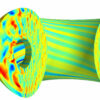At CERN’s Large Hadron Collider (LHC), studies of rare processes allow scientists to infer the presence of heavy particles, including undiscovered particles, that cannot be directly produced. Such particles are widely anticipated to exist beyond the Standard Model, and could help explain some of the enigmas of the universe, such as the existence of dark matter, the masses of neutrinos (elusive particles originally thought to be massless) and the universe’s matter-antimatter asymmetry.
One such process is the rare decay of neutral B mesons to a muon and antimuon pair: the heavier cousin of the electron paired with its corresponding antiparticle. There are two types of neutral B mesons: The B0 meson consists of a beauty antiquark and a down quark, while for the Bs meson the down quark is replaced by a strange quark. If there are no new particles affecting these rare decays, researchers have predicted that only one in 250 million Bs mesons will decay into a muon-antimuon pair; for the B0 meson, the process is even more rare, at only one in 10 billion.
Scientists have been searching for experimental confirmation of these decays since the 1980s. Only recently, in 2014, was the first observation of the Bs to muons decay reported in a combined analysis of data taken by the LHCb and CMS collaborations, later confirmed by the ATLAS, CMS and LHCb experiments individually. However, the B0 decay still eludes any attempt to observe it.
Using data from Run 2 of the LHC, the CMS experiment has released a new study of the decay rate and the lifetime of the Bs meson decay, as well as a search for the B0 decay. The new study, presented at the International Conference on High Energy Physics (ICHEP), benefits from not only a large amount of data analyzed, but also advanced machine learning algorithms that single out the rare decay events from the overwhelming background of events produced by millions of particle collisions per second.
The results revealed a very clear signal of the Bs meson decaying to a muon-antimuon pair. The precision of the decay rate measurement exceeds that achieved in previous measurements in other experiments.
Both the observed Bs decay rate, found to be 3.8 ± 0.4 parts in a billion, and its lifetime measurement of 1.8 ± 0.2 picoseconds (one picosecond is one trillionth of a second), are very close to the values predicted by the Standard Model.
As for the B0 decay, although no evidence of it was found from these results, physicists can state with 95% statistical confidence that its decay rate is less than 1 part in 5 billion.
In recent years, a number of anomalies have been observed in other rare B meson decays, with discrepancies between the theoretical predictions and the data—indicating the potential existence of new particles. The new CMS result is much closer to theoretical predictions than these other rare decays and so could help scientists to understand the nature of the anomalies.
Rare B meson decays continue to be of great interest to scientists. With the Bs meson to muons decay firmly established and measured with high precision, scientists are now setting their sights on the ultimate prize: the B0 decay. With large data sets anticipated from LHC Run 3, they hope to catch the first glimpse of this extremely rare process and learn more about the puzzling anomalies.
More information:
cms.cern/news/new-study-rare-b … son-decays-two-muons
Citation:
Researchers measure rare particle decay with high precision (2022, July 14)


